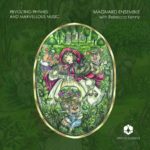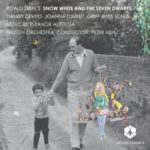Sections: Information | Description | CD Cover | Norwegian Cover
- Musical work commissioned by Roald Dahl Foundation in 1992
- Composed by British composer Paul Patterson
- Libretto by Donald Sturrock
- Performances:
- World premiere at Royal Festival Hall, London, 1st Nov 1992
- Conducted by Frans Welser-Möst
- Performed by London Philharmonic Orchestra
- Narrators: Julie Walters, Benjamin Luxon and Stephen Powell
- Roald Dahl Gala Concert, King’s Place, London, December 2008
- Conducted by Peter Ash
- Performed by pianists Aleksandar Madzar and Julien Libeer, and Joan Rodgers (soprano)
- Narrator: Geraldine James
- Movies:
For more information, see Music Link International. To hire, contact Josef Weinberger Ltd.
Description
From Paul Patterson’s website:
The original suggestion, from the author’s widow, was for a setting of a group of his much-loved Revolting Rhymes. Donald Sturrock, who had made a film about Dahl in 1985 and became a friend of the family, volunteered to adapt the text. Then, by great good fortune, a script Dahl had written for a possible television adaptation, using puppets, of one of the Rhymes was found: his inspired re-telling of the story of Little Red Riding Hood and the Wolf. Sturrock realised that this could form the basis of a single longer work, and devised a text in which Dahl’s original verses were augmented by prose dialogue and narration.
This is the text which Paul Patterson has set as a concert piece, lasting a little under half an hour, for three speakers (or one) and orchestra. The words are spoken freely against the orchestral background, without any attempt to notate exact rhythms for the verse – something Dahl disliked in previous settings of his words. The orchestra at the beginning becomes an Enchanted Forest, through which the Narrator makes his way to begin the story. Thereafter it illustrates the narrative, with themes to match the characters and the action, in the popular tradition of Prokofiev’s Peter and the Wolf and Poulenc’s Babar the Elephant.
The music is straightforward, easy to follow and, the composer says, “very tuneful – amazingly so for me”. But it is certainly not without its incidental delights for listeners of all ages: the little bursts of ‘avant-garde’ free-time notation for the thunderstorm near the beginning and, later on, for a death scene; the musical menu of possibilities for the wolf’s lunch, in the course of which Wagner’s Isolde is scandalously identified as a ‘juicy cow’; Grandma’s doorbell, which has unexpected classical aspirations; the representation of a wolf’s burp by the percussion instrument called a ‘lion’s roar’; and what Patterson calls the ‘cat-walk’ music for Little Red Riding Hood’s final appearance. Above all, in this story which hinges on characters pretending to be other characters, there is a great deal of ingenuity in the way that the themes associated with one character similarly impersonate those of another. But then, as the Narrator says near the beginning, in the Forest, “appearances can be very, very deceptive. Nothing is ever quite what it seems….”
CD Cover
Norwegian Cover – Lille Rødhette
-

- Gyldendal Tiden, 2000




